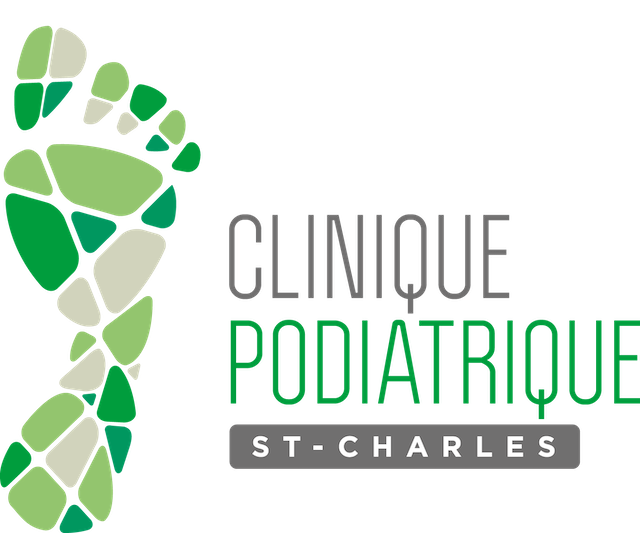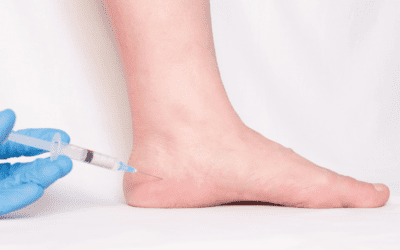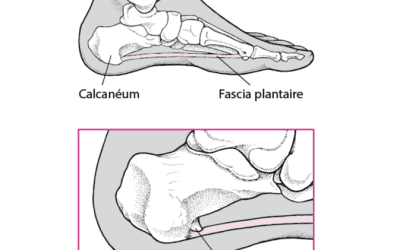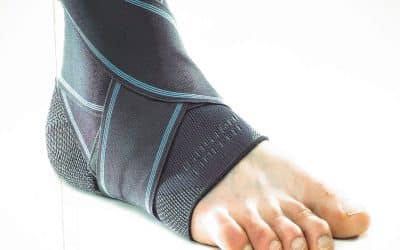Plantar fasciitis and heel spurs are conditions frequently encountered in podiatry, sparking growing interest among both health professionals and patients.
Historically, these pathologies are closely related to the anatomy and biomechanics of the foot, particularly the structure of the plantar fascia, a thick connective tissue extending from the heel to the toes.
The heel spur, on the other hand, is a bone growth forming on the heel, these often painful conditions affect a wide variety of patients, from athletes to the elderly. Understanding the anatomy of the foot, especially the plantar arch and the heel, is crucial to grasp the nature of these pathologies.
The human foot is a complex structure made up of 26 bones, over 30 joints, and a dense network of muscles, tendons, and ligaments. The ankle, serving as a joint between the foot and the leg, plays a crucial role in mobility and balance. The plantar fascia, a thick connective tissue, plays an essential role in supporting the foot’s arch. It absorbs shocks and aids in propulsion during walking. The biomechanics of the foot involve the study of movements and forces acting on the foot.
Each step involves a complex sequence of movements, where the foot absorbs the impact of contact with the ground, adapts to the terrain, and helps propel the body forward. Poor biomechanics, such as excessive pronation (inward rolling of the foot) or supination (outward rolling), can increase stress on the plantar fascia, potentially leading to plantar fasciitis.
Plantar fasciitis and heel Spurs symptoms and signs
Plantar fasciitis and heel spurs are two distinct foot conditions, each with its characteristic symptoms, although their treatments can often overlap.
Plantar fasciitis: A sharp and insidious pain
Plantar fasciitis is primarily manifested by a sharp pain in the heel, often compared to the sensation of walking on a nail. This pain, which can also present as an intense burning or stabbing sensation, is typically centered around the heel, although it may extend along the sole of the foot.
A distinctive sign of plantar fasciitis is its tendency to be more intense in the morning. The first steps after getting out of bed are often the most painful, a consequence of the nocturnal contraction of the fascia. Similarly, after prolonged sitting periods, the pain tends to worsen, although it may temporarily decrease with initial movement before intensifying again after prolonged activity.
Heel spur: A localized and persistent pain
In contrast, the heel spur, characterized by a bone growth on the calcaneus, causes a more localized and constant pain.
This pain, often felt as a sting or sharp pressure under the heel, is particularly evident when direct pressure is applied to the bone growth area. Unlike plantar fasciitis, the pain associated with a heel spur is generally less related to activity or inactivity cycles, remaining relatively constant throughout the day, although certain activities may exacerbate it.
These symptoms, although distinct, can sometimes present simultaneously in some patients, making diagnosis and treatment more complex.
It is crucial to be evaluated by a health professional to confirm the diagnosis and develop a personalized treatment plan. Understanding these symptoms and their nuances is essential not only for diagnosis but also to guide treatment and prevention strategies.
Diagnosis
The diagnostic process often involves a thorough clinical examination by the podiatrist, who assesses pain, ankle flexibility, muscle strength, and walking mechanics.
Biomechanics
- Static Observation: The podiatrist observes the patient’s posture while standing. They examine the alignment of the ankles, the presence of normal, high, or lowered (flat feet) plantar arches, and the symmetry of both feet.
- Palpation: The podiatrist palpates different foot structures to identify tender or swollen areas, which may indicate inflammation or injury.
- Joint Mobility Tests: Tests are performed to assess the mobility and flexibility of the foot and ankle joints.
- Gait Analysis: The patient is observed walking, often on a treadmill. The podiatrist evaluates pronation (inward rolling of the foot) and supination (outward rolling), weight distribution on the foot, and the fluidity of the gait.
- Video Analysis: Sometimes, video analysis may be used to capture fine details of the gait, allowing for a more accurate assessment.
- Heel Palpation: Direct pressure is applied to specific areas of the heel to determine the exact location of the pain, which can help differentiate plantar fasciitis from heel spurs.
Medical imaging, including X-rays, ultrasounds, or MRIs, plays a key role in confirming the presence of a heel spur and ruling out other causes of heel pain.
X-ray
X-ray is an essential diagnostic method for detecting heel spurs. This imaging technique uses X-rays to create detailed images of the foot bones. It not only confirms the presence of a bone growth at the heel but also excludes other causes of heel pain such as fractures or arthritis. Although X-ray is not used to diagnose plantar fasciitis, it can help rule out other pathologies.
Ultrasound
Ultrasound is another useful diagnostic technique, particularly for plantar fasciitis. It uses sound waves to produce images of soft tissues, thus allowing the assessment of the thickness and health of the plantar fascia. Ultrasound can detect signs of inflammation and tears in the fascia, which is crucial for an accurate diagnosis of plantar fasciitis.
Prevention and risk factors
These two conditions share several risk factors, such as obesity, prolonged wearing of inappropriate shoes, intense physical activities, and certain types of feet, like flat feet or high arches. Preventing these conditions includes maintaining a healthy weight, choosing shoes that offer good arch support, avoiding excessively impactful activities for the feet, and regularly practicing specific strengthening and stretching exercises for the foot and ankle.
Home and Podiatrist treatment
Rest and Ice Application
Rest is more than just a break; it is an integral part of the healing process. For people suffering from plantar fasciitis or heel spurs, reducing activities that put pressure on the foot is essential.
This means limiting walking, prolonged standing, and especially high-impact sports activities that could worsen the condition. Rest gives the plantar fascia and surrounding tissues the necessary time to recover and repair.
This is particularly crucial right after symptoms appear, where avoiding additional strains can prevent the worsening of pain.
Alongside rest, applying ice is an effective method for managing pain and inflammation. Ice, applied safely, can help reduce swelling and calm inflammation in the affected area.
It is generally advised to apply an ice pack wrapped in a cloth or towel to avoid direct contact with the skin, which could cause cold-induced injuries. The application should last about 15 to 20 minutes, several times a day, especially after any activity that could have strained the foot. In addition to other treatments prescribed by a health professional, such as stretching exercises or orthotics, rest and ice application can greatly contribute to symptom reduction and accelerate the healing process.
Cortisone injections
Cortisone injection is a medical procedure where a powerful steroid is injected directly into the affected area to reduce inflammation and pain.
Mechanism: Cortisone is an anti-inflammatory that works by reducing inflammation and swelling in the affected tissues. When injected into the heel area, it can provide rapid and significant pain relief for patients suffering from plantar fasciitis or heel spurs.
Examples: A cortisone injection can be particularly effective when severe inflammation limits mobility or the patient’s quality of life. After the injection, patients may experience pain relief in the days following, although results may vary.
Rapid Pain Relief: Cortisone injections can offer rapid and significant pain relief in cases of severe inflammation.
Reduction of Inflammation: They directly target inflammation, which can be beneficial when other treatments have failed.
Plantar orthotics
Plantar orthotics are custom-made devices inserted into shoes to support, align, prevent, or correct biomechanical abnormalities of the foot. They play a crucial role in the treatment of plantar fasciitis and heel spurs.
Mechanism: Orthotics are custom-designed to fit the unique shape of the patient’s foot. They work by evenly distributing weight and pressure across the entire sole of the foot, thereby reducing tension on the plantar fascia.
For people suffering from heel spurs, orthotics can be designed to cushion and protect the heel, thus reducing pressure on the bone growth.
For example, for a patient with a high plantar arch suffering from plantar fasciitis, an orthotic can be designed to offer additional arch support, thereby reducing tension on the fascia. Conversely, for a flat foot, the orthotic will provide support to raise the plantar arch and distribute pressure more evenly.
- Customized Support: Plantar orthotics are custom-designed to fit the specific shape of the patient’s foot, offering targeted support where it’s most needed.
- Pain Reduction: By redistributing pressure on the foot, they help reduce the pain and discomfort associated with plantar fasciitis and heel spurs.
- Improved Function: By correcting biomechanical abnormalities, orthotics can improve the function of the foot and ankle, which is beneficial for walking and other activities.
- Adaptation Period: There may be an adaptation period during which the patient gets used to the orthotics. In rare cases, they may initially cause discomfort or require adjustments.
Taping technique
Taping, or strapping, is a non-invasive method to support the foot and limit movements that aggravate the pain of plantar fasciitis or heel spurs.
Mechanism: Taping is strategically applied to support the plantar arch and reduce tension on the plantar fascia. This technique also helps stabilize the foot, reducing excessive movement that can aggravate pain.
Examples: A common taping for plantar fasciitis is the “low-Dye strapping.” This taping starts under the foot, goes up around the heel, and ends on the opposite side of the foot. It aims to support the arch and reduce excessive pronation.
- Immediate Support: Taping offers instant support and can be applied just before an activity that strains the foot.
- Prevention of Harmful Movements: It helps limit movements that aggravate pain, like excessive pronation.
- Accessibility: It’s an accessible and non-invasive option that can be used in conjunction with other treatments.
- Comfort: Some people may find the taping uncomfortable or restrictive.
New laser technology
Low-level laser therapy is a relatively new technology used to accelerate healing and reduce inflammation and pain. The laser stimulates cellular regeneration and improves blood circulation in the affected area.
Anti-inflammatory medications
Non-steroidal anti-inflammatory drugs (NSAIDs) are commonly prescribed to reduce inflammation and pain associated with plantar fasciitis and heel spurs. They should be used cautiously and under medical supervision. By combining these diagnostic and treatment techniques, podiatrists can offer a comprehensive approach to managing plantar fasciitis and heel spurs.
Advanced diagnostic and treatment techniques
Aside from surgery, several advanced techniques have emerged for treating plantar fasciitis and heel spurs. Shockwave therapy, for example, uses sound waves to stimulate healing in the plantar fascia. Other non-surgical approaches include cryotherapy, laser therapy, and various types of physiotherapy. These methods aim to reduce inflammation, promote tissue healing, and relieve pain.
Difference between plantar fasciitis and heel spurs
Although often confused due to their similar location, these two conditions differ. Plantar fasciitis is an inflammation of the plantar fascia, while heel spurs are characterized by a bone growth on the heel.
The heel spur, in contrast, is a bone growth that develops on the calcaneus, the heel bone. This growth is often a response to continuous tension or repeated traumas on the attachment point of the plantar fascia or other tendons to the heel. Risk factors for developing a heel spur include gait abnormalities, flat feet or high arches, and aging, which can lead to a decrease in the elasticity of the fascia.
Evaluation by the Podiatrist
The podiatrist performs a comprehensive evaluation of the foot, taking into account the foot structure, pain history, and physical activity of the patient. This evaluation may include gait analysis and checking for plantar warts or flat feet, which can aggravate symptoms.
To prevent and treat plantar fasciitis and heel spurs, several exercises and activities are recommended.
Stretching the plantar fascia, such as Achilles tendon and toe stretches, can help relieve tension and pain. Strengthening exercises for the foot and ankle muscles can also help support the foot’s arch. Low-impact activities like swimming or cycling can be beneficial, as they allow for fitness maintenance without exerting excessive pressure on the foot.
Exercise
This program aims to stretch, strengthen, and increase the flexibility of the plantar fascia, foot muscles, and Achilles tendon.
Achilles tendon and calf stretch
- Starting position: Stand facing a wall, move one foot forward and keep the other behind.
- Place your hands on the wall at shoulder height.
- Keep the heel of the back foot firmly on the ground and the knee straight.
- Slowly move your pelvis towards the wall until you feel a stretch in the calf and Achilles tendon of the back leg.
- Hold this position for 30 seconds.
- Repeat 2-3 times for each leg.
Sole of the foot stretch
- Starting position: Sitting, legs stretched out in front of you.
- Use a towel or elastic band, placing it around the front of your foot.
- Gently pull the towel towards you while keeping your knee straight until you feel a stretch under your foot.
- Hold this position for 15-30 seconds.
- Repeat 2-3 times for each foot.
Toe strengthening
- Starting position: Sitting with your feet flat on the ground.
- Try to lift your toes while keeping the rest of the foot on the ground.
- Hold the position for 5 seconds, then release.
- Repeat 10 times.
Ball rolling under the foot
- Starting position: Sitting or standing.
- Place a tennis ball or massage ball under your foot.
- Roll the ball under your foot for a few minutes, applying moderate pressure to massage the sole of the foot.
Heel raises
- Starting position: Standing, feet flat on the ground.
- Slowly lift your heels off the ground, rising onto the tips of your toes.
- Hold the position for a few seconds, then slowly return to the starting position.
- Do 2-3 sets of 10 repetitions.
Toe flexions
- Starting position: Sitting, legs extended in front of you.
- Flex and extend your toes as much as possible.
- Repeat this movement for a few minutes for each foot.
- It is important to perform these exercises regularly, ideally every day, for the best results.
Plantar fasciitis and heel spurs in athletes
Why the Pain Sets In: Athletes intensely use their feet through repetitive and high-impact activities. This continuous solicitation can cause excessive tension on the plantar fascia, leading to the inflammation and pain characteristic of plantar fasciitis. The heel spur can develop in response to this chronic tension on the heel.
Prevention and treatment
Make prevention a game: Imagine prevention as a warm-up before the big match. Before diving into your favorite sport, take a few minutes to wake up your feet with gentle stretches. Think of these stretches as your own pre-competitive ritual!
Shoes: Your Secret Equipment: Your sports shoes are not just an accessory; they are your armor! Invest in shoes that support your adventure, offering comfort and protection at every step.
Mix up your routine: Vary your training like a conductor changes the melody. Alternating between different types of exercises is not only fun but also gives your feet a much-needed break.
Treatment: Rest is Your Ally: After an intense day, give your feet a well-deserved break. Rest and recovery are the keys to coming back stronger.
Massage and cold: Your Best Friends: Imagine ice and massages as a magical balm for your tired feet. A small post-workout session can work wonders to reduce inflammation.
Strengthen to shine: Incorporate strengthening exercises into your routine to make your feet as robust as the rest of your body.
Plantar fasciitis and heel spurs in factory workers
Why the pain sets in: Factory workers spend long hours standing, often on hard surfaces, and wear safety shoes that are not always designed for comfort or foot support. This combination can increase pressure on the plantar fascia and heel, promoting the development of plantar fasciitis and heel spurs.
Your shoes, your fortress: In the daily battle in the factory, your safety shoes are your first line of defense. Choose them like a knight chooses his armor, with support that protects and softness that comforts.
- Magic mats: An anti-fatigue mat is like a magic carpet for your feet. It absorbs the shock and hardness of the factory floor, allowing your feet to feel lighter and happier.
- Active break: The Little Extra: Transform your breaks into mini stretching sessions. It’s a golden opportunity to reenergize your feet and thank them for their hard work.
- Ice: Your Mini Home Spa: Once home, treat your feet to a spa session with ice. It’s a refreshing remedy that soothes inflammation and pampers your feet.
- Orthopedic insoles: Custom Comfort: Think of orthopedic insoles as a custom cushion for your feet. They provide comfort and support where your feet need it most.
- Expert advice: Don’t forget to consult a podiatrist for personalized advice. They are like architects for your feet, building a custom treatment plan to keep you moving.
In conclusion, plantar fasciitis and heel spurs are complex pathologies requiring a careful approach.
Prevention, focused on choosing suitable shoes, maintaining a healthy weight, and regularly practicing exercises, plays a crucial role. The podiatrist’s role is essential in diagnosing, treating, and educating patients about these conditions. It is important to remember that understanding these conditions and their treatments greatly contributes to improving the quality of life of those affected.




